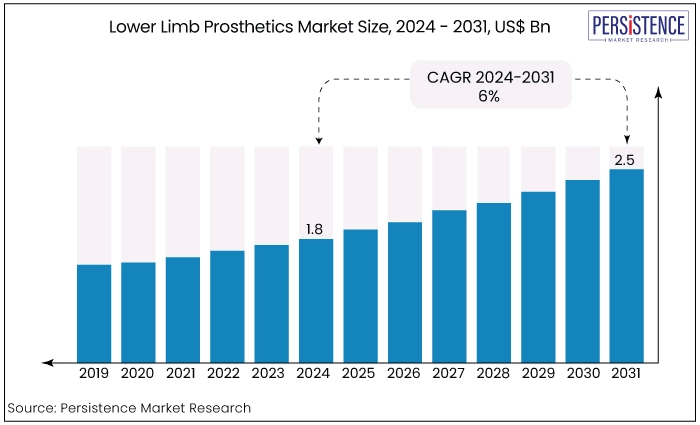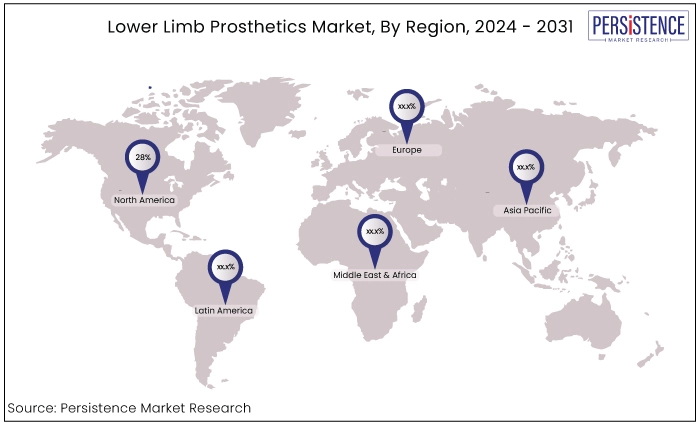Lower Limb Prosthetics Market
Industry: Healthcare
Published Date: August-2024
Format: PPT*, PDF, EXCEL
Delivery Timelines: Contact Sales
Number of Pages: 181
Report ID: PMRREP34738
The lower limb prosthetics market is estimated to reach a valuation of US$2.5 Bn by the end of 2031 from US$1.8 Bn recorded in 2024. The market is expected to record a CAGR of 6% during the forecast period from 2024 to 2031.
Key Highlights of the Market
|
Market Attributes |
Key Insights |
|
Market Size (2024) |
US$1.8 bn |
|
Market Size (2031) |
US$2.5 bn |
|
Forecast Growth Rate (CAGR 2024 to 2031) |
6% |
|
Historical Growth Rate (CAGR 2019 to 2023) |
4.4% |

|
Region |
Market Value Share in 2023 |
|
North America |
28% |
North America is the most prominent regional market for lower limn prosthetics. The regional market growth is due to high occurrence of limb loss, the availability and use of advanced devices, favourable reimbursement patterns, and significant healthcare spending. The Amputee Coalition predicts that by 2050, around 3.6 million people in the United States will be living with limb loss.

Europe was the second most influential area in the global market. The region's substantial market share is expected to be driven by several positive aspects, including a favourable governmental and reimbursement policy, and the adoption of innovative technology.
The market expansion is fuelled by the increasing number of strategic acquisitions made by major competitors to have a strong presence in European countries. By this, Ottobock's successful acquisition of Livit B.V. in February 2022 is a significant development that aims to expand its patient care network across Western Europe. These strategic moves are expected to further boost market expansion in the region.
Asia Pacific region holds significant growth potential, driven by its robust aging population. It is expected to witness the highest CAGR due to the large number of elderly people and the rising prevalence of diseases like diabetes. In contrast, the rest of the world sector experienced a decline in market share in 2023.
The region's future growth is likely to be influenced by factors such as increased awareness of these products and rising healthcare spending in major nations, notably Brazil.
|
Category |
Market Value Share in 2023 |
|
Type - Prosthetic Leg |
30% |
The lower limb prosthetics market is further segmented into prosthetic leg, prosthetic knee and prosthetic foot based on type where the prosthetic leg segment dominated the market and estimated to continue dominating. This segment dominated with a market share of 30%, owing to the widespread availability and effectiveness of prosthetic legs, which offer complete mobility solutions for people who have had amputations above or below the knee.
Escalating military conflicts in different areas also stimulate the need for prosthetic limbs. In accordance with this, ABC News reported that the demand for prosthetic legs and arms had significantly risen as a result of the Russia-Ukraine conflict, according to a leading Ukrainian medical professional specializing in manufacturing limbs for amputees.
|
Category |
Market Value Share 2023 |
|
Technology - Conventional Lower Extremity |
42% |
The market for lower limb prosthetics is further sub segmented into conventional lower extremity, electric powered lower extremity and hybrid lower extremity based on technology. Among these segments, the conventional lower extremity segment dominates the market share.
Traditional lower limb prosthetic devices have a well-established history of being dependable and long-lasting. Prosthetics and patients thoroughly understand prosthetics' design and functionality, which fosters trust and confidence.
The lower limb prosthetics market is a diverse sector within the medical devices business, specializing in the creation, production, distribution, and utilization of prosthetic devices. Such devices designed to assist individuals who have lost their lower limbs due to disease, trauma, or congenital abnormalities.
Devices come in a wide range of advanced materials, designs, and technologies. This diversity caters to the various needs and preferences of patients, highlighting the industry's ability to provide personalized solutions.
The market is being driven by the increasing incidence of lower limb amputations globally, primarily due to rising rates of diabetes, vascular diseases, and traumatic injuries. As the global population ages and the prevalence of chronic conditions such as diabetes continues to grow, the number of individuals requiring lower limb prosthetics is also on the rise.
Advancements in materials science, robotics, biomechanics, and medical imaging have spurred market innovation. Consequently, resulted in prosthetic devices that offer improved functionality, durability, and integration with the human body. Also, increasing awareness and support from healthcare systems, along with government initiatives aimed at improving access to prosthetic care, are contributing to market expansion.
Many countries are enhancing insurance coverage and reimbursement policies for prosthetic devices, making them more affordable and accessible to a broader population. As a result, more individuals are able to benefit from advanced prosthetic solutions, which is positively impacting the growth of the market.
Manufacturers also collaborate closely with orthopaedic surgeons, physical therapists, rehabilitation specialists, and prosthetics, among other healthcare professionals.
The lower limb prosthetics market experienced significant growth prior to 2023, driven by advancements in technology, increasing prevalence of diabetes and vascular diseases, and rising numbers of trauma cases and amputations.
Innovations such as microprocessor-controlled prosthetics, improvements in materials like carbon fiber, and enhanced customizability contributed to the market's expansion. Additionally, the aging population and increased healthcare spending in developed regions supported market growth.
Government initiatives and funding for research and development further bolstered the industry's development. Post-2024, the market share is expected to continue its growth trajectory. This growth is fueled by ongoing technological advancements, such as integration with artificial intelligence (AI) and the Internet of Things (IoT), which enhance prosthetic device functionality and user experience.
Adopting 3D printing for more personalized and cost-effective prosthetic solutions will likely to become more widespread. Moreover, emerging markets, particularly in Asia and Latin America, are anticipated to contribute significantly to market growth due to improving healthcare infrastructure and increasing awareness about advanced prosthetic options.
Increasing Prevalence of Diabetes and Vascular Diseases
The increasing prevalence of diabetes and vascular diseases is another critical growth driver for the lower limb prosthetics market.
Conditions like diabetes can lead to severe complications, including peripheral artery disease and neuropathy, which often result in lower limb amputations. The growing number of such cases worldwide has led to a higher demand for prosthetic limbs.
Moreover, as awareness about the availability and benefits of advanced prosthetic solutions increases among patients and healthcare providers, more individuals are seeking these devices post-amputation. This trend is particularly notable in developed regions, where the incidence of diabetes and vascular diseases is high.
The readiness of the healthcare systems in these regions to provide advanced prosthetic care is crucial, and policymakers play a significant role in ensuring this readiness.
Technological Advancements
Technological advancements are a primary driver of growth in the lower limb prosthetics market. Innovations such as microprocessor-controlled knees and ankles, which adapt in real-time to various terrains and user movement have significantly enhanced the functionality and comfort of prosthetic devices.
Materials like lightweight carbon fibre have made prosthetics more durable and easier to use, reducing fatigue for wearers. Additionally, integrating robotics and artificial intelligence (AI) has led to the development of smart prosthetics that can predict user intentions and adjust movements accordingly.
Technological improvements not only enhance the quality of life for users but also attract more individuals to opt for advanced prosthetic solutions, thereby driving the market growth.
Government Initiatives and Funding
Government initiatives and funding play a significant role in driving the growth of the market. Many governments across the globe are increasingly focusing on improving the quality of life for amputees by providing better access to advanced prosthetic devices. This includes funding for research and development to innovate more effective and affordable prosthetic solutions.
Several countries have implemented policies that provide financial assistance or insurance coverage for prosthetic devices, making them more accessible to a larger population.
These initiatives support the development and adoption of advanced prosthetics and encourage companies to invest in new technologies and expand their product offerings. As a result, government support is a crucial factor propelling the market forward.
High Cost of Advanced Prosthetics
One significant restraint for the growth of the market is the high cost associated with advanced prosthetic devices. Cutting-edge prosthetics, including microprocessors, robotics, and advanced materials, can be expensive for many patients. This financial barrier is especially pronounced in developing regions, where healthcare budgets are limited, and insurance coverage for such devices often needs to be improved.
The high cost limits the adoption of advanced prosthetics and exacerbates disparities in access to quality prosthetic care. As a result, many individuals needing prosthetics need help from the latest technological advancements, slowing the overall market growth.
Limited Awareness and Accessibility in Developing Regions
Another key restraint is the limited awareness and accessibility of advanced prosthetics in developing regions. Many patients and healthcare providers in these areas need to be fully informed about the latest advancements in prosthetic technology and their potential benefits.
The infrastructure to support the distribution and maintenance of advanced prosthetics is often lacking, making it challenging to reach those in need. These barriers to awareness and accessibility hinder the market's growth potential in regions with a significant need for lower-limb prosthetics.
Efforts to improve education, infrastructure, and healthcare policies are necessary to overcome these challenges and expand the market's reach globally.
Expansion in Emerging Markets
Expanding into emerging markets presents a significant growth opportunity for the lower limb prosthetics market. Countries in Asia Pacific, Latin America, and Africa are experiencing rapid economic development, leading to improvements in healthcare infrastructure and increased healthcare spending. Such advancements make it feasible to introduce and expand access to advanced prosthetic technologies previously limited to developed regions.
The incidence of conditions leading to amputations, such as diabetes, vascular diseases, and traumatic injuries is rising in many emerging markets. However, awareness and availability of advanced prosthetic solutions still need to be improved.
Prosthetics manufacturers can tap into a large, underserved population by focusing on these regions. Companies can work alongside local governments, NGOs, and healthcare providers to educate the public about the benefits of modern prosthetic devices, thereby increasing demand.
Investing in localized manufacturing can help reduce costs and make prosthetics more affordable for a broader population segment. Another critical aspect of capitalizing on this opportunity is customization and innovation tailored to local needs. Developing prosthetics that consider these regions' specific environmental and cultural contexts can lead to better user acceptance and satisfaction.
Furthermore, digital technologies such as telehealth and remote monitoring can provide ongoing support and maintenance for prosthetic users in remote locations, ensuring they receive the care and adjustments needed to optimize their use of the devices.
The presence of several key players, including Ottobock, Össur, Blatchford Group, and Hanger Clinic, characterizes the competitive landscape of the market. These companies are at the forefront of innovation, continuously developing advanced prosthetic technologies such as microprocessor-controlled limbs and myoelectric prosthetics.
The market is also witnessing increasing competition from new entrants and regional manufacturers, particularly in emerging markets. Strategic partnerships, mergers, and acquisitions are expected as companies seek to expand their product portfolios and geographic reach.
Investments in R&D and collaborations with research institutions are crucial for maintaining a competitive edge. The market is dynamic, with companies striving to enhance the functionality, affordability, and accessibility of prosthetic solutions.
Recent Industry Development in the Lower Limb Prosthetics Market
|
Attributes |
Details |
|
Forecast Period |
2024 to 2031 |
|
Historical Data Available for |
2019 to 2023 |
|
Market Analysis |
US$ Billion for Value |
|
Key Regions Covered |
|
|
Key Market Segments Covered |
|
|
Key Companies Profiled in the Report |
|
|
Report Coverage |
|
|
Customization & Pricing |
Available upon request |
By Type
By Technology
By End User
By Region
To know more about delivery timeline for this report Contact Sales

The market is estimated to reach a valuation of US$2.5 Bn by the end of 2031.
The market is estimated to exhibit a growth rate of 6% over the forecast period.
Enovis, Fillauer, Ossur (Touch Bionics), Ottobock SE, Endolite, are the largest manufacturers of lower limb prosthetics.
Rising prevalence of diabetes and vascular diseases are the key market drivers.
The conventional lower extremity segment dominates the market share.